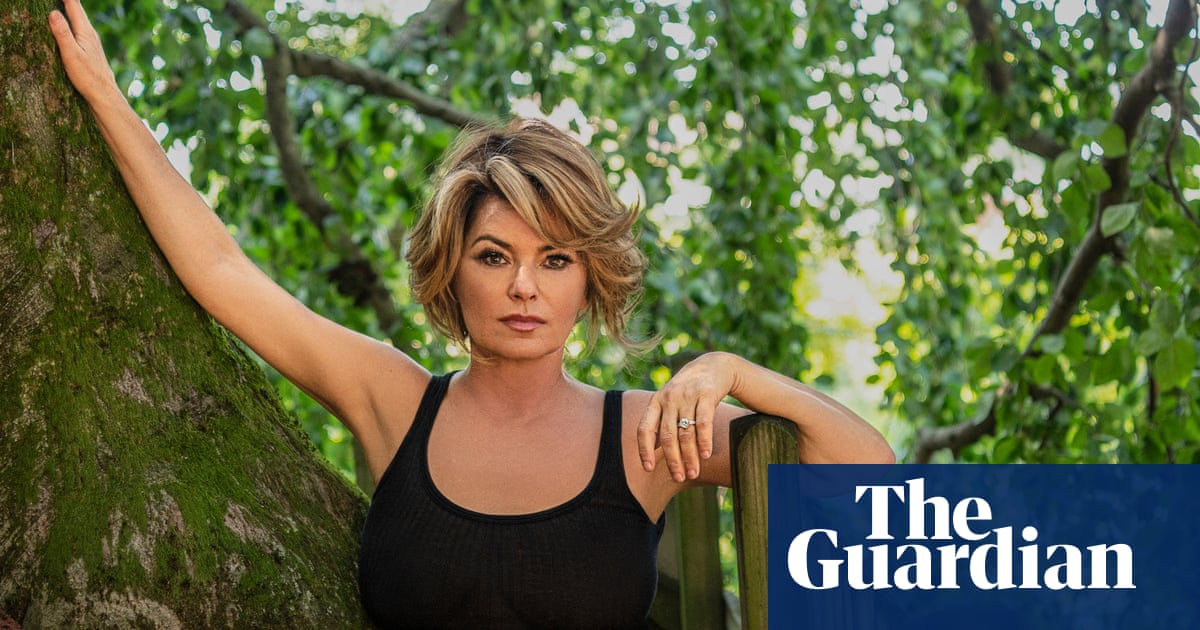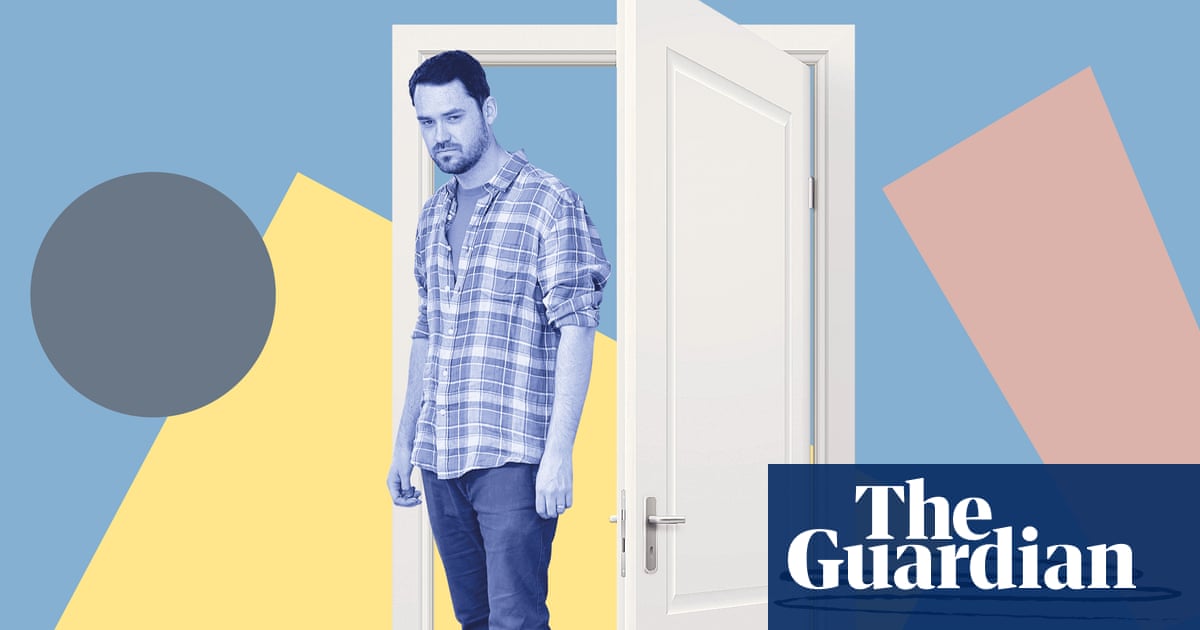
‘What’s your favourite track?” Shania Twain asks, about her new album, speaking to me over a video call from her home in Switzerland. She has a strange approachability, as if you already know her, and not just because she has been famous since for ever. Even in the slightly vaudevillian years, she had those friendly eyes and a straightforwardness that now, at 57, she doesn’t try to mask.
My favourite track on Queen of Me, since she asks, is the first one, Giddy Up!, although I’m not sure it’s the right answer, as it’s light, playful, not the crunchiest. She seems OK with that, though: “It was my advice song, you know? It’s a silly way of saying: ‘Put some pep in your step, get some spice in your life, you know, put some up in your giddy.’ It’s really got a country stomp to it, and attitude, for sure.”
This has always been the puzzle with Twain. Usually, when music tells you to cheer up, or love yourself, or feel empowered, it’s shallow or simplistic. But Twain comes at it with the deadly seriousness of lived adversity. Even in the 90s, behind her showgirl, pop-crossover persona, all midriff and hats, there was gritty resilience.
Queen of Me is only her sixth studio album, which is surprising, considering the length of her career (if you count from when she started singing in bars as a child, it covers five decades) and her profile (she is the bestselling female artist in country music history). There is a nice line in last year’s Netflix documentary Not Just a Girl, when her manager, Jon Landau, says she “left a lot of money on the table”. He was talking about her decision not to go on tour after her second album and international breakthrough, The Woman in Me. “The tour was put off only for creative reasons,” she says. “I needed to create, and I was not ever going to go back out on stage again to do cover songs, which I’d done all my life, unless I was doing it by choice.”
This feels typical of how she approaches her career, and probably her life: she says something only when she has something to say. “I don’t make a lot of albums. I’m definitely not one of those artists or thinkers who do a lot of it, hoping some of it will appeal,” she says. “With this album, especially, I’ve felt more comfortable in my own skin, experimenting a little bit more. I’m just in a less apologetic place in my life. And I think that allows me to worry less, you know?”
She took a long hiatus in 2003 after her voice began to deteriorate inexplicably. It wasn’t until nine years later, when she was embarking on her first residency in Las Vegas, that the problems with her voice were linked to a diagnosis of Lyme disease. “The funny thing is – and I have to laugh at myself, as a singer – that it affected the nerves in my vocal cords. It is ironic, but I still feel lucky, because it could have gone to my organs.” An operation fixed the problem, but her voice was left changed: “It’s definitely deeper and raspier now, but I don’t mind the new characteristics in there.”
To understand the importance of those vocal cords, you have to go back to Ontario in the 1970s. Twain was living with her mother, her stepfather – whom she always refers to as her father, having had no contact with her biological father since she was two – two sisters and two brothers. Her mother was a “big, big supporter”, she says, but it’s a bit more complicated than that: “I was her hope, the one who would make it. I think she recognised the dysfunction in our life, and thought that side would be solved somehow along the way. She loved me as a mother as well, but she was very, very passionate about my talent. In terms of economic status, I couldn’t afford to go to a performing arts school – my education was in a bar.”
In fact, they couldn’t really afford to take her to bars, either – her stepfather worked in reforestation and her mother earned little to nothing, dealing with depression as well as five children. “Putting gas in the car to go to a bar for me to sing” was a constant source of conflict between her parents, Twain remembers. “That created a lot of tension and a lot of arguing between them. That was not very fun for me, as a child, being caught in the middle.” She pauses. “I hated it. They wanted success for me, but they just couldn’t afford it. Money is often at the root of domestic violence, which was the case for us.”
Her stepfather sexually abused her, too, from the age of 10; it’s only recently that she has spoken about this publicly. She never had a chance to confront him, because he and her mother were killed in a car crash in 1987, when she was 22.
It’s a complicated picture, but she feels sorrow that neither of them got to see her success. She was named the Country Music Association’s entertainer of the year in 1999, becoming the first non-US citizen to earn the accolade. But she had been winning album and song awards consistently, from the CMA and the American Music awards, since 1996.
“When I started to win awards was when it really bothered me the most that my parents were not there to see the glory. Because I felt that they had sacrificed so much. And they deserved to share in those moments,” she says. “It was a treacherous relationship, anyway, for all of us. The sacrifice on their part was just suffering through all of those arguments. And, in the end, I make it and they’re not there to say: ‘Well, at least it was for something.’ It’s very painful. It’s very, very sad that they never got to see one moment of it.”
There was so much riding on her performances as a child that she talks about the stress of bar-singing as if it were yesterday. “You can’t afford a monitor system good enough to support your hearing, so you’re oversinging – that’s bar-singer syndrome. You’re exhausting your voice.”
She spent years struggling with stage fright, too, despite always looking as if she was having the time of her life. “It’s really only recently that I’ve turned some sort of corner. There are so many scars there. Stage fright is a very scarring experience, a terrible, panicky feeling. But now, going from ‘I may never sing again’ to being where I am, I’m like: ‘In this moment, if I hit a bad note, I’m going to wear that scar as a survival flag.’ So I’m feeling triumphant. It’s like a lion that can roar again.”
After her parents died, Twain returned to Ontario to look after her siblings, supporting them by singing in a resort. It wasn’t until six years later that she made it to Nashville. “I wasn’t prepared for it to be such a man’s world,” she says.
One way in which Twain felt original, in the 90s, was that she went against country’s gender codes. Male stars could sing about anything – drinking meth and running over their woman by accident, then shooting a dog, then crying about the dog – while the women were expected to be innocent, chaste and sexy, but in a God-fearing way. It wasn’t so much a double standard as a wild mismatch – and Twain rejected it. “My naivety was good, because I was just focusing on proving myself as an artist, not as a woman, and that’s a very big difference. But I was very surprised by it. By the time I was writing songs like Man! I Feel Like a Woman!, those were born out of that early phase in Nashville and even my bar phase.”
Cracking the mainstream brought out run-of-the-mill sexism. In 1993, she met, fell in love with, collaborated with and married the celebrated rock producer Mutt Lange. In 1995, she released The Woman in Me, her first of three consecutive albums that sold at least 10m copies in the US. She was the first female artist to achieve this.
In early interviews, she was treated like a pretty face with a svengali behind her. In fact, she had been writing her own songs since she was 10, while the collaborations with Lange were exactly that. She laughs about it now, but she wasn’t laughing at the time. “I definitely had to manage my surprise in a lot of those cases. It would have been my job to share my involvement in those interviews, but I felt awkward about it, because I thought: ‘Am I just going to sound defensive? Why should I have to stand up for myself?’ So I ended up going: ‘Think whatever you want,’ because the alternative was exhausting: trying to certify myself when all I wanted to do was write more songs.”
She and Lange moved to Switzerland in the late 1990s. “I was starting to become famous and I like my solitary time. I wanted to live somewhere where I could forget who I was. Pretty much anywhere else, I’d be recognised or approached. And it’s hard to forget that you’re actually not on stage, which gets you in a weird frame of mind. I just wanted to live like a normal person.” The couple had a son in 2001, Eja, and divorced in 2010, reportedly due to his affair with her best friend. She married the friend’s husband, Frédéric Thiébaud, in 2011.
She talks about Lange in generous terms, careful not to minimise or denigrate the time they had or the work they did together. “I really recognise him as one of the greats. With or without the personal life, there’s nothing bad to say about the incredible music that was created. He was an important part of the story – not as an ex-husband, as an ex-music collaborator.”
She retraces her steps over this sentence a number of times. “There couldn’t be one without the other. That was the sad part. Even though in my mind, of course, I can separate them, the songs are as much his as they are mine. Knowing that we would never make music again together … that is a shame, I think, musically, creatively.”
She is hamstrung by her own fair-mindedness: determined to give Lange his due, while not misrepresenting her feelings about him.
She remains peeved at the friend, but to find that out you would have to listen to her fifth album, Now, released in 2017. “One of my favourite albums, I think. I was back to just being an independent songwriter. I learned to enjoy it again and to write songs from a deeper place in my heart. It was very cathartic and very necessary.”
The rage ballad will never be her scene, though, and Queen of Me is truer to Twain’s form. “It’s very chirpy, and that’s intentional. It’s more playful than I’ve ever been. I can write really sad songs, but do my fans want to hear really sad songs from me?”
On the one hand, her fans will take whatever she gives them. On the other, ever since Man! I Feel Like a Woman!, she has known what it’s like to make something universally delightful– and that is her preference. “It just became everybody’s song. It’s kind of a bridge song, a unifier. I was talking about myself and it was genuine. Then it resonated with everyone: men, women, children. The LGBTQ+ community, I guess, see that song as one of their celebration songs. It’s very touching for me. It’s touching because it’s so all inclusive.”












